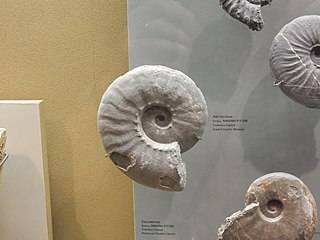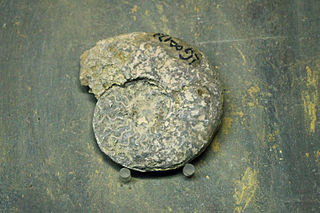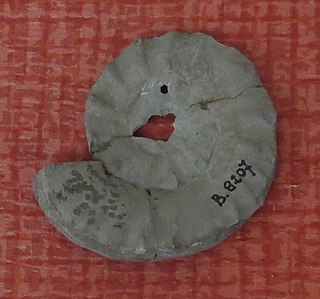
Ammonoids are extinct, (typically) coiled-shelled cephalopods comprising the subclass Ammonoidea. They are more closely related to living octopuses, squid, and cuttlefish than they are to nautiluses. The earliest ammonoids appeared during the Emsian stage of the Early Devonian, with the last species vanishing during or soon after the Cretaceous–Paleogene extinction event. They are often called ammonites, which is most frequently used for members of the order Ammonitida, the only remaining group of ammonoids from the Jurassic up until their extinction.

Placerias is an extinct genus of dicynodonts that lived during the Carnian to the Norian age of the Triassic Period. Placerias belongs to a group of dicynodonts called Kannemeyeriiformes, which was the last known group of dicynodonts before the taxon became extinct at the end of the Triassic.

The Carnian is the lowermost stage of the Upper Triassic Series. It lasted from 237 to 227.3 million years ago (Ma). The Carnian is preceded by the Ladinian and is followed by the Norian. Its boundaries are not characterized by major extinctions or biotic turnovers, but a climatic event occurred during the Carnian and seems to be associated with important extinctions or biotic radiations. Another extinction occurred at the Carnian-Norian boundary, ending the Carnian age.

In the geologic time scale, the Changhsingian or Changxingian is the latest age or uppermost stage of the Permian. It is also the upper or latest of two subdivisions of the Lopingian Epoch or Series. The Changhsingian lasted from 254.14 to 251.9 Ma ago. It is preceded by the Wuchiapingian age/stage and is followed by the Induan age/stage.

The Early Triassic is the first of three epochs of the Triassic Period of the geologic timescale. It spans the time between 251.9 Ma and 246.7 Ma. Rocks from this epoch are collectively known as the Lower Triassic Series, which is a unit in chronostratigraphy. The Early Triassic is the oldest epoch of the Mesozoic Era. It is preceded by the Lopingian Epoch and followed by the Middle Triassic Epoch. The Early Triassic is divided into the Induan and Olenekian ages. The Induan is subdivided into the Griesbachian and Dienerian subages and the Olenekian is subdivided into the Smithian and Spathian subages.

In the geologic timescale, the Olenekian is an age in the Early Triassic epoch; in chronostratigraphy, it is a stage in the Lower Triassic series. It spans the time between 249.9 Ma and 246.7 Ma. The Olenekian is sometimes divided into the Smithian and the Spathian subages or substages. The Olenekian follows the Induan and is followed by the Anisian.

The Induan is the first age of the Early Triassic epoch in the geologic timescale, or the lowest stage of the Lower Triassic series in chronostratigraphy. It spans the time between 251.9 Ma and 249.9 Ma. The Induan is sometimes divided into the Griesbachian and the Dienerian subages or substages. The Induan is preceded by the Changhsingian and is followed by the Olenekian.
Xenoceltites is an extinct genus of ceratite ammonoid found worldwide in the Lower Triassic.
Anaflemingites is an extinct genus of cephalopods belonging to the Ammonite subclass.
Anatibetites is an extinct genus of cephalopods belonging to the Ammonite subclass.
Anagymnotoceras is an extinct genus of cephalopods belonging to the Ammonite subclass.

Arctoceras is a genus of ceratitid ammonoids from the Lower Triassic with a moderately narrow discoidal shell and ceratitic suture.

Mylacanthus is an extinct genus of prehistoric coelacanth lobe-finned fish that lived during the Smithian age of the Early Triassic epoch in what is now Svalbard.

Flemingites is an extinct genus of evolute ammonoid from the Smithian with spiral ridges on the shell.
The Vikinghøgda Formation is a geologic formation in Svalbard, Norway. It preserves fossils dating back to the Early Triassic (Griesbachian-Spathian) period. It is split into three members, from oldest to youngest: the Deltadalen Member (Induan), Lusitaniadalen Member (Smithian), and Vendomdalen Member (Spathian). The formation can be found in central Spitsbergen, southern Spitsbergen, as well as the smaller islands of Barentsøya and Edgeøya. The type locality is positioned in the vicinity of Vikinghøgda and Sticky Keep, two low peaks along the southeast edge of Sassendalen in Spitsbergen. The two upper members of the Vikinghøgda Formation were previously grouped together as the Sticky Keep Formation.
James Perrin Smith was an American geologist and paleontologist.
Microcnemus is an extinct genus of lizard-like early archosauromorph reptiles from the Protorosauridae. Members of the genus lived during the Early Triassic period in Russia. Once believed to have been an ancestor to lizards, Microcnemus is now known to be one of the oldest members of the lineage that would eventually lead to archosaurs such as crocodilians and dinosaurs. The type species, M. efremovi, was named in 1940 by the German palaeontologist Friedrich von Huene.

Tirolites is an extinct genus of ammonoid cephalopod. Its first appearance defines the Smithian-Spathian boundary in the Olenekian stage of the Early Triassic epoch. It is prominent in the Paris biota.
Liostrea is a genus of extinct oysters, marine bivalve mollusks in the family Gryphaeidae.

Paredestus is a monotypic genus of extinct eugeneodont holocephalan from the Early Triassic of Canada. The type and only species, P. bricircum represents the last known member of the superfamily Edestoidea and among the last known eugeneodonts. It was named in 2008 based on tooth and jaw material, with the holotype representing the only known specimen.











